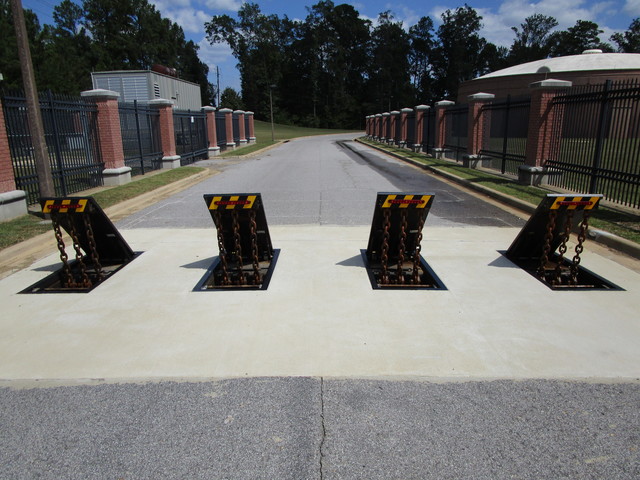The Greatest Guide To Wedge Barriers
5 Simple Techniques For Wedge Barriers


18 may be done quicker, easily, and price successfully. FIG. In certain personifications, the anchor 30 might be a steel framework including plates, light beams(e. g., I-beams ), and/or various other structures that are protected within the foundation 14, which may be concrete. At the surface area 12, a top side 28 of the anchor 30 might be at the very least partly revealed
, therefore enabling the add-on of the barrier 10 to the support 30. g., threaded holes)in several beam of lights or plates of the support 30 might be revealed to the surface area 12. In this way, screws 32 or various other mechanical bolts may be used to secure the obstacle 10 to the anchor 30. As the barrier 10 is mounted to the surface 12 of the foundation 14, collection of debris and other material beneath the barrier may be decreased, and components of the bather 10 might not be exposed to below grade atmospheres. As shown by recommendation numeral 52, the training system 50 includes parts got rid of below the wedge plate 16. The parts 52 beneath the wedge plate 16 may include an electromechanical actuator, a webcam, one or even more web cam surfaces, and so forth. Furthermore, the training device 50 consists of a spring setting up 54
The springtime pole 58 is coupled to a camera(e. g., webcam 80 displayed in FIG. 4) of the lifting device 50. The springs 60 disposed concerning the spring pole 58 are kept in compression by spring sustains 62, including a dealt with spring assistance 64. That is, the fixed springtime assistance 64 is taken care of relative to the foundation 14 and the rest of the bather 10.
The Basic Principles Of Wedge Barriers
The remaining force pop over to this site used to
the cam to deploy the wedge plate 16 may be provided supplied an electromechanical actuator 84 or other various other. The springtime assembly 54 and the actuator 84(e. Wedge Barriers. g., electromechanical actuator)may run together to convert the webcam and raise the wedge plate 16.
As stated above, the springtime setting up 54 applies a constant pressure on the web cam, while the electromechanical actuator may be regulated to exert a variable pressure on the camera, thereby enabling the training and lowering( i. e., deploying and withdrawing )of the wedge plate 16. In particular personifications, the constant force used by the spring setting up 54 may be adjustable. g., electromechanical actuator) is handicapped. As will be valued, the spring assembly 54 might be covered and protected from debris or other components by a cover plate(e. g., cover plate 68 shown in FIG. 4) that might be significantly flush with the raised surface 38 of the structure 14. As stated over, in the released setting, the wedge plate 16 serves to block gain access to or traveling past the barrier 10. For instance, the obstacle 10(e. g., the wedge plate 16 )might block pedestrians or cars from accessing a building or pathway. As discussed over, the barrier 10 is affixed to the support 30 secured within the structure 14,

front brackets 71. Consequently, the link settings up 72 might pivot and turn to enable the collapse and extension of the affiliation settings up 72 during retraction and deployment of the bather 10. The linkage settings up 72 reason motion of the wedge plate 16 to be limited. For instance, if a lorry is taking a trip towards the released wedge plate 16(e. As an example, in one condition, the safety and security legs 86 may be prolonged throughoutupkeep of the obstacle 10. When the safety and security legs 86 are released, the safety and security legs 86 sustain the weight of the wedge plate 16 against the surface 12. As a result, the lifting system 50 might be shut off, serviced, eliminated, replaced, etc. FIG. 5 is partial perspective view of a personification of the surface-mounted wedge-style barrier 10, illustrating the web cam 80 and the webcam surfaces 82 of the training device 50. Particularly, two cam surface areas 82, which are described as reduced webcam surfaces 83, are placed listed below the camera 80. The lower web cam surface areas 83 may be fixed to the surface 12 (e. For instance, the reduced cam surfaces 83 and the mounting plate 85 might develop a solitary item that is safeguarded to the anchor 30 by screws or other mechanical bolts. Furthermore, 2 webcam surfaces 82, which are referred to as top webcam surface areas 87, are positioned above the web cam 80 and coupled to (e. In other personifications, intervening layers or plates may be positioned in between the surface 12 and the lower webcam surface areas 83 and/or the wedge plate 16 and the upper web cam surfaces 87 As stated above, the webcam
80 converts along the cam surface areas 82 when the wedge plate 16 is raised from the withdrawed setting to the released position. Additionally, as discussed above, the springtime setting up 54 (see FIG. 3 )may offer a force acting upon the webcam 80 in the instructions 102 via springtime pole 58, which might minimize the force the electromechanical actuator 84 is required to relate to the cam 80 in order to activate and lift the wedge plate 16. 1 )to the deployed placement(see FIG. 4). As shown, the web cam 80 consists of track wheels 104(e. g., rollers), which get in touch with and convert along the webcam surface areas 82 during operation.